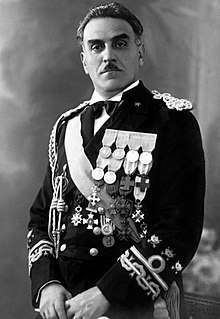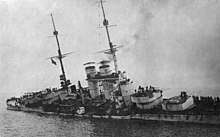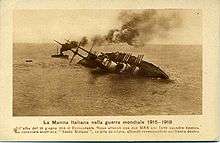Luigi Rizzo
Luigi Rizzo, 1st Count of Grado and Premuda (1887–1951), nicknamed the Sinker, was an Italian admiral. He is mostly known for his distinguished service in World War I; as a torpedo boat commander having sunk no fewer than two Austro-Hungarian battleships (SMS Wien in 1917 and SMS Szent István in 1918).
Luigi Rizzo | |
|---|---|
 Rear Admiral Luigi Rizzo in 1935 | |
| Born | 8 October 1887 Milazzo |
| Died | 27 June 1951 (aged 63) Rome |
| Allegiance | |
| Service/ | |
| Rank | Divisional Admiral |
| Battles/wars | First World War Second Italo-Abyssinian War Second World War |
| Awards | Gold Medal of Military Valor (2) |


Biography
After receiving his training at the Naval Academy in Livorno, Rizzo was appointed a ship-of-the-line sub-lieutenant of the Italian Navy in 1912. He saw action in the First World War (1915–1918) when he conducted several spectacular raids as commander of torpedo boats (PT boat MAS) against ships of the Austro-Hungarian Navy.
In December 1917, Rizzo sank the Austro-Hungarian pre-dreadnought battleship SMS Wien while it was at anchor inside the defences of Trieste harbour.
On 10 February 1918, three MAS boats (with the MAS 96 commanded by Rizzo) attacked Austrian shipping inside the harbour of Bakar (now in Croatia), a port in an enclosed bay near Fiume at the head of the Kvarner Gulf. As it lay 80 km in a sheltered waterway, it was thought to be beyond attack, so the raid was intended as a psychological assault as well as a physical one. It became widely known as the Bakar mockery (Italian: Beffa di Buccari).
On 10 June 1918 Rizzo sank the large battleship SMS Szent István off Premuda. The sinking of the 21,700-ton ship, the greatest success of any MAS torpedo boat, is considered an important part of Italian naval history[1] and is celebrated by the Italian Navy on 10 June every year.
In 1919 Rizzo took part in the seizure of the city of Fiume (now Rijeka in Croatia) led by Gabriele d'Annunzio. He retired from active service in 1920 with the rank of commander.
He received the Gold Medal of Military Valor (twice), the Silver Medal (four times), the Cross of War, and was a knight of the Order of the Crown of Italy. France awarded Rizzo the Croix de guerre and made him a knight of the Légion d'honneur; the United Kingdom honoured him with its Distinguished Service Order; and the President of the United States awarded him the Navy Distinguished Service Medal.[2]
Admiral Miklós Horthy, Commander-in-Chief of the Austro-Hungarian Fleet in WWI and leader of the Otranto Raid which saw the sinking of SMS Szent István, as Regent of the Kingdom of Hungary awarded Rizzo the Royal Hungarian Order of Saint Stephen.
In his later life, Rizzo worked in shipping businesses and shipyards, and volunteered during the Second Italo-Abyssinian War.
He eventually rose to the rank of Divisional Admiral and was ennobled by King Victor Emmanuel III of Italy, taking the victory title of Conte di Grado e di Premuda.
In September 1943, after he ordered the sinking of ships to prevent them from being commandeered by the Nazis,[3] Rizzo was charged with sabotage and deported to Germany. When the war ended, his daughter located him and they returned to Italy. Rizzo died in 1951 after a long illness.
Admiral Count Rizzo was second cousin to Captain Victor P. Rizzo of Lawrenceville, New Jersey (USA), a World War II reconnaissance pilot and author, and to Rose Rizzo-Goff, both of whom were children of Leonardo Rizzo (first cousin to Adm. Luigi Rizzo) and Camilina Dell'Utri-Rizzo of Brooklyn, New York (USA).
Notes
Bibliography
- Kennedy, Paul. The Sinking of the Szent Istvan, in "The History of the First World War", BPC Publishing Ltd., Bristol, England, 1971, vol.7, no.14, pps:3072 – 3075.